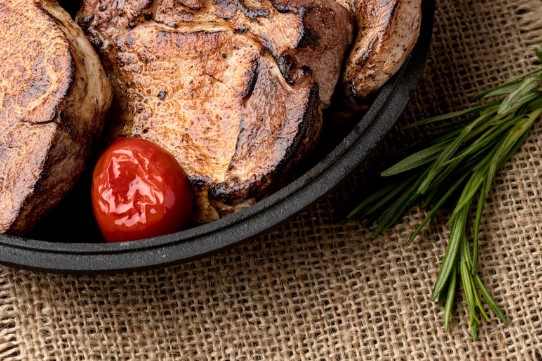When Did Aged Meat Become Popular In High-End Steakhouses?
When Did Aged Meat Become Popular In High-End Steakhouses?

Aged meat, with its rich flavor and tender texture, has become a hallmark of high-end steakhouses. This process, whether through dry aging or wet aging, enhances the meat’s quality, making it a sought-after delicacy among discerning diners. Rosebud Steakhouse, renowned for offering an authentic Chicago steakhouse experience, proudly serves superior quality aged cuts sourced locally from the Midwest. But when did aged meat become a staple in high-end steakhouses? This blog post delves into the history, evolution, and reasons behind the popularity of aged meat in top-tier dining establishments.
The Origins of Meat Aging
The practice of aging meat dates back to ancient times when preservation was crucial for survival. Early methods involved hanging meat in cool environments to prevent spoilage. Over time, people discovered that this process not only preserved the meat but also enhanced its flavor and tenderness. This laid the foundation for modern meat aging techniques.
The Evolution of Dry Aging
Dry aging, the process of hanging beef in a controlled, refrigerated environment, became popular in the early 20th century. Initially, it was a necessity due to the lack of refrigeration technology. However, as the benefits of improved flavor and texture became evident, dry aging evolved into a deliberate practice. Today, Rosebud Steakhouse uses state-of-the-art dry aging methods to deliver superior quality cuts.
The Advent of Wet Aging
Wet aging emerged in the 1960s with the advent of vacuum-sealing technology. Unlike dry aging, wet aging involves sealing the meat in plastic bags and allowing it to age in its own juices. This method is more cost-effective and reduces weight loss due to dehydration. At Rosebud Steakhouse, we offer both dry and wet-aged options, catering to diverse palates.
High-End Steakhouses and the Renaissance of Aged Meat
The resurgence of aged meat in high-end steakhouses began in the late 20th century. Chefs and restaurateurs, seeking to differentiate their offerings, turned to traditional practices like dry aging to create unique dining experiences. This period saw an increased appreciation for the complex flavors and textures that aging imparts, elevating aged meat to a status symbol in gourmet dining.
Culinary Pioneers and the Aged Meat Revolution
Renowned chefs and culinary pioneers played a crucial role in popularizing aged meat. Figures like Wolfgang Puck and Peter Luger championed the use of aged meat in their steakhouses, showcasing its potential through innovative dishes. Their success inspired other high-end establishments to adopt similar practices, further cementing aged meat’s place in luxury dining.
The Science Behind Meat Aging
Understanding the science of meat aging is key to appreciating its popularity. During the aging process, natural enzymes break down muscle fibers, enhancing tenderness. Additionally, the loss of moisture concentrates the meat’s flavor, resulting in a richer taste. This scientific foundation underscores why aged meat is highly valued in culinary circles.
The Role of Quality Suppliers
The rise of aged meat in high-end steakhouses is also attributed to quality suppliers like Linz Heritage Angus Beef. These suppliers ensure consistent, high-grade meat suitable for aging. Rosebud Steakhouse’s partnership with Linz Heritage Angus Beef exemplifies our commitment to offering the best aged meat, sourced from trusted local providers.
Aged Meat in Modern High-End Dining
Today, aged meat is a cornerstone of high-end dining. Steakhouses worldwide feature aged cuts as signature offerings, often highlighting the aging process on their menus. This trend reflects a broader consumer demand for premium, flavorful meats. At Rosebud Steakhouse, we continue this tradition, ensuring every steak is meticulously prepared for an exceptional dining experience.
Consumer Demand and Aged Meat
Consumer preferences have significantly influenced the popularity of aged meat. As diners become more knowledgeable and adventurous, there is a growing appreciation for the nuanced flavors of aged meat. This shift has driven high-end steakhouses to prioritize aged cuts, aligning with the evolving tastes of their clientele.
The Future of Aged Meat in Steakhouses
Looking ahead, the popularity of aged meat shows no signs of waning. Advances in aging techniques and a sustained interest in culinary excellence suggest that aged meat will remain a staple in high-end steakhouses. Rosebud Steakhouse is committed to staying at the forefront of this trend, continually refining our offerings to deliver unforgettable dining experiences. For more information to visit here rosebudsteak.com
Conclusion
The journey of aged meat from a preservation necessity to a luxury dining staple is a testament to its enduring appeal. High-end steakhouses like Rosebud Steakhouse have embraced this tradition, offering guests superior quality, aged cuts that exemplify culinary excellence. As consumer demand for premium aged meat continues to grow, its presence in top-tier dining establishments is set to remain robust. Whether you prefer dry-aged or wet-aged, the rich flavors and tender textures of aged meat promise a memorable dining experience, celebrating the best of what high-end steakhouses have to offer.
